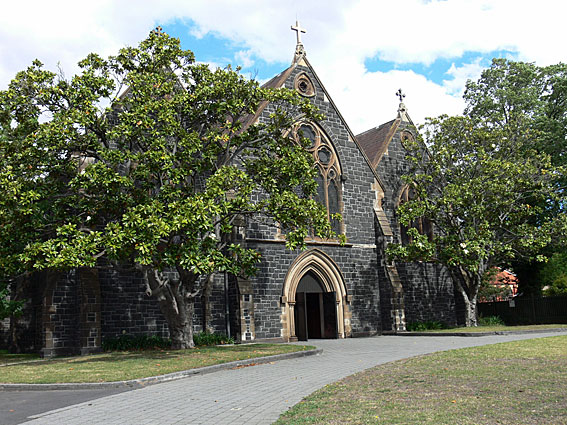
All Saints' Anglican Church, East St Kilda: the main façade facing west
[photograph by John Maidment (21 November 2008)]

All Saints' Anglican Church, East St Kilda: the main façade facing west
[photograph by John Maidment (21 November 2008)]
Historical and Technical Documentation by John Maidment
© OHTA, 2012 (last updated December 2012)
The nave of All Saints' was designed by the architect Nathaniel Billing. The foundation stone was laid by Bishop Perry on 8 November 1858 and the building first used for worship on 8 December 1861.1 The first section comprised only three bays of the nave and aisles, and addition of a further two bays was begun in 1866. Nathaniel Billing (1821-1910) was a capable architect whose other church work included Christ Church, Warrnambool, St John's, Port Fairy and St George's, Geelong; he was a former pupil of the English architect George Gilbert Scott.2 He produced his initial design for All Saints' in 1857, a model of which stands in the north transept of the church. This envisaged a nave and aisles of five bays, with a chancel to the east, flanked on one side by a 135ft tower and spire, and on the other side by a vestry. This was to be a 'hall church' in which the nave and aisles were of almost equal height, without a clerestory; the general style was Decorated Gothic. It would appear that Billing's design may have been adapted from that of the important London Tractarian church of St Mary Magdalene, Munster Square, although only the nave of Billing's design was ultimately adhered to. Another influence may have been the Catholic churches at Kilmore and Kyneton, based upon designs by the English architect Charles Hansom, which employ a comparable configuration of nave and aisles.
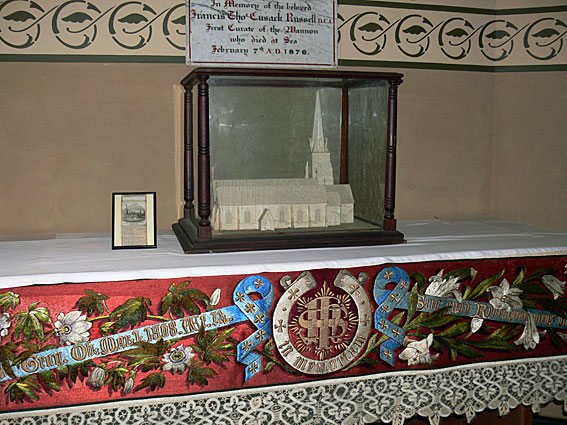
All Saints' Anglican Church, East St Kilda: model of Nathaniel Billing's design in the north transept
[photograph by John Maidment (9 December 2012)]
The following account of the building was published in London:
This church is now in course of erection, and it is proposed at present to finish the western half of it which will contain 660 persons, at an expense of about 4,000 pounds. The whole building when complete will accommodate 1,100 persons, and cost about 12,000 pounds. The Incumbent is the Rev. J.H. Gregory. The body of the church consists of a nave and two aisles, which are together 107 feet 6 inches long, and 64 feet, 6 inches wide, the nave being divided from the aisles by freestone pillars having moulded capitals and bases. At the east end of the nave is the chancel, thirty-five feet long, with the organ chamber and vestry, attached to the side walls. There are three public entrances to the church; on the west side is the principal entrance; and on the north and south side are porches, with seats on each side, as in ancient churches. The western elevation has three gables, of which the centre one will be surmounted by a stone bellcote for temporary use until the completion of the bell tower and spire. The west windows are respectively four and three lights; the aisle windows are double lights, the upper parts pierced with trefoiled and quatrefoiled openings; and the east or chancel window contains five lights. The tower, with the spire, will be 135 feet high, and sufficiently solid to contain a peal of bells. The design is chaste, simple and without superfluous ornamentation; the style of architecture being Gothic at the time of Henry III, with, however, some special adaptations to the altered climate. Ample provision has been made for ventilation by means of large gratings inserted in the plinth, admitting air as required beneath the floor of the church. Large ventilators are also placed in the gables and windows and in the roofs. The floors of the passages will be laid with ornamental patterns in tiles. Mr Nathaniel Billing, of Melbourne, is the architect.3
In 1874-1875, the transepts, chancel and sanctuary were erected to the designs of Frederick Wyatt. In 1884, the organ chamber and vestries were added, also to Wyatt's design (who had died on 28 March 1878), supervised by Terry & Oakden, and the north chapel was built in 1890-91. The completed building was consecrated by Bishop Goe on 8 November 1892, although the chancel and sanctuary were not decorated until 1898.
The following description appeared in 1876:
MELBOURNE CHURCHES: ALL SAINTS' CHURCH, ST. KILDA. This church, of which we give an interior view, was commenced November, 1858, and has since received two additions, extending from west to east, in order to meet the increasing requirements of the parish. The building comprises a nave, north and south aisles and transepts, chancel-aisle, chancel, and sanctuary. It is 166ft. in length, and 63ft. wide across the nave and aisles, and 110ft. from north to south transept wall. The chancel, the largest in the colony, is 54ft. in length by a width of 23ft. The style chosen is Early English of the geometric period. The material used in the construction is bluestone, with Tasmanian freestone dressings, arches, and pillars. At the east end is a sanctuary and chancel, divided from .the nave by a dwarf chancel-screen wall of freestone. The chancel arch is supported by two polished granite columns, with richly carved capitals. The choir stalls are arranged on each side of the chancel, and the organ stands in the south-chancel aisle. A panelled freestone arcade forms the end of end of the sanctuary, which, is apsidal in form, and. is enriched with five stained-glass windows, representing, respectively, the Saviour and the evangelists. These windows, as well as two others of the clear story of the chancel, were presented by two members of the congregation. The altar, which is placed 4ft. above the floor of the nave, is of polished oak, carved and panelled, and relieved by four stone pillars with carved capitals. In the transept is a very handsome carved stone pulpit, presented by some of the ladies of the congregation. The chancel and sanctuary are lighted by four brass corono and two very handsome burnished brass standard lights, the gifts of members of the congregation. The western portion-viz., the nave and aisles - was designed by Mr. N. Billing, of Melbourne, and the transepts, chancel and sanctuary by Mr. Frederick Wyatt, architect, also of this city. The church is still unfinished, it being intended at some future date to erect a tower and spire, with narthex and baptistry, at the west end ; to raise the roofs of the chancel aisles, at present only temporary; and to build some additional vestries at the east end. The incumbent is the Rev. J.H. Gregory, who has been in charge since the parish was formed, some 20 years since. He is assisted in his public ministrations by a surpliced choir, consisting of a precentor (the Rev. W.A. Brooke), with an organist and choirmaster, assistant organist, 12 lay desks, and 20 choristers. The services are choral. Hymns Ancient and Modern are in use. The church is capable of seating about 1,300 persons. Its cost of erection to the present time is about £12,000. The annual income is derived from seat rents and offertory collections, there being no state aid.4
The building consists of a nave and aisles of five broad bays, apsidal transepts, and a chancel and apsidal sanctuary, flanked to the north by an apsidal chapel and to the south by an organ chamber, with an extensive range of vestries adjacent, on two levels, including an apsidal choir practice room, reflecting the church's pre-eminent choral tradition. Organists of All Saints' have included H.J. Inge, A.C. Lenton, L.A. Hardy, B.D. Clarke and K. Sutton.
The apsidal transepts are particularly unusual, this form having been suggested by the vicar at the time, the Revd J.H. Gregory, as a result of his European travels. Medieval examples include the French cathedrals of Noyon and Soissons, and the German church of St Elisabeth, Marburg.
All Saints possesses an extremely spacious interior and is among the largest Anglican parish churches in the country. The range of fittings is lavish, including two brass candelabra from King George II's chapel at Windsor Castle, placed on the chancel screen, still retaining their gas lighting. The chapel screen, in wrought iron and brass, was made by the highly renowned English arts-and-crafts metal worker Nelson Dawson (1859-1942) and is the finest example of this work in the country. The vast wooden canopy and screen at the west end, in Tasmanian oak and Queensland beech, was designed by Louis R. Williams (1890-1980) and embraces a baptistery, narthex and war memorial; the carving was carried out by H. Reding and the constructional work by Buckley & Nunn. There are many fine stained glass windows by the English firm of Clayton & Bell and the Melbourne firm of Ferguson & Urie.
The interior of the building was restored in 2009 and the decorative wall treatments expertly revived by Mulholland Restoration and Decorating.
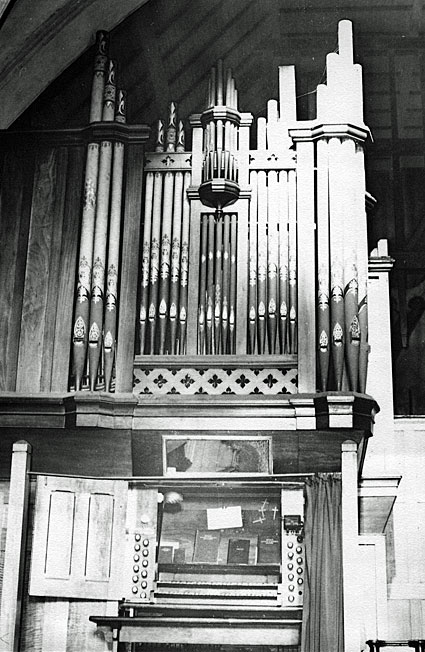
All Saints' Anglican Church, East St Kilda: the Fincham organ
as photographed at St Andrew's Anglican Church, Clifton Hill
[photograph by Christopher Hill (circa 1974)]
A new organ was built for the church by George Fincham. This was opened on 28 October 1868. The following account appeared the next day:
Last evening, the new organ built by Mr. Fincham, of Richmond, at All Saints' Church St. Kilda, was formally opened, and it being the feast of St. Simon and St. Jude, there was a full choral evening service. The place was crowded with a large congregation, and the service was performed with admirable musical effect. Mr. G. R. G. Pringle presided at the organ, Mr. Edwards, the ordinary organist, giving way on this occasion; and the choir, which included several amateurs, ladies and gentlemen, of much merit, did their part well. The Magnificat (Atwood in C) was given magnificently; the Nunc Dimittis (Smith in B flat) went equally well; and the anthem taken from Mozart's "Twelfth Mass" was delivered in excellent style. The concluding voluntary, a prelude and fugue in D, by Sebastian Bach, was not only a piece of fine execution, but well developed the beauties of the new instrument. The sermon was preached by the Rev. H.H.P. Handfield. As the organ fund has hitherto been very limited, the organ itself can be only regarded as the skeleton of an instrument, but such as it is it is in every way worthy of Mr. Fincham, who has once more shown how well deserved was the high opinion of him expressed by Mr. C.E. Horsley and others of our distinguished Australian musicians. At present the All Saints' organ has only one manual, with swell, eight stops, and a pedal and coupler, but it is intended for three manuals, and movements suitable to large size and great power. It has so far cost only £250, and it seems to be the general opinion that the price is ridiculously small. On next Sunday, being All Saints' Day, the tenth anniversary of the dedication of the church will be duly celebrated by choral services. After last night's performance, the choir were entertained with light refreshments at the orderly room, and the health of the ladies and gentlemen of the choir, Mr. Edwards the organist, Mr. Fincham the organ builder, and the incumbent and church authorities of the parish, wore duly drunk and responded to.5
Initially only a single manual instrument, consisting of a Swell Organ, an unenclosed Choir Organ was added by George Fincham and the instrument reopened on 25 January 1872:
The re-opening of the organ at All Saints' Church, St. Kilda, was an event which attracted a very large congregation yesterday evening. There were some 800 people inside, and a large number outside the church. The Rev. R. Potter, of Hotham, was the officiating minister. During the evening the capabilities of the new organ were displayed in a very masterly way by Mr. J. Edwards, the organist of the church, who was particularly successful in a selection from Mendelssohn's "Athalie," commencing "Heaven and the earth display," in which a well trained choir of nearly 60 singers also took part. The organ, which is entirely the work of Mr. Fincham, of Richmond, has no pretensions to external beauty, but consisting, as it does, of swell, choir and pedal organs, it is very good of its kind, especially in the flute, claribella, and clarionet stops, which are of a very sweet and genuine quality. At the offertory the larghetto movement from Beethoven's symphony in D was very much admired. It is to be noted that amongst so large a congregation, something less than £25 was collected. The rest of the musical selections, which lasted some time after the service was over, ranged between J.S. Bach and the much more modern Batiste.6
The specification of this instrument was as follows:
| CHOIR (1871) Clarabella Viol de Gamba Dulciana Gemshorn Flute Piccolo Cremona Swell to Choir |
8 8 8 4 4 2 8 |
TC TC |
|
| SWELL (1868) Double Diapason Open Diapason Stopd Diapason Clarabella Keraulophon Principal Flute Fifteenth Sesquialtera Trumpet Oboe |
16 8 8 8 8 4 4 2 III 8 8 |
CC-BB TC TC TC 17.19.22/12.15.17 |
|
| PEDAL (1868) Open Diapason Choir to Pedal Swell to Pedal |
16 8 8 |
Compass: 56/29
3 composition pedals to Choir
3 composition pedals to Swell
Lever swell pedal
Mechanical key and stop action7
The organ remained in this state until its removal from All Saints' Church. The projected Great Organ was never added. The provision of Swell and Choir Organs follows the precepts of The Revd Frederick Heathcote Sutton8 and this was also followed by George Fincham in his 1871 organ for Christ Church, Daylesford.
This organ was sold to St Andrew's Anglican Church, Clifton Hill in 1924 and erected there by George Fincham & Sons Pty Ltd, the previous organ at Clifton Hill being moved to St John's Anglican Church, Sorrento. The Fincham organ remained at Clifton Hill until the church was demolished in 1975. Parts of the 1868/1871 Fincham organ were used in a new organ built in 1976 by George Fincham & Sons Pty Ltd for Our Lady Help of Christians Catholic Church, Eltham.
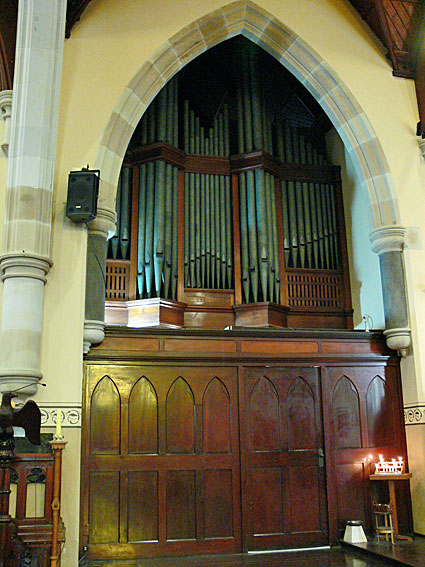
All Saints' Anglican Church, East St Kilda: the Roberts organ – transept case
[photograph by John Maidment (9 December 2012)]
A new organ built by Roberts Ltd of North Adelaide was opened in October 1924. It was reported that on Sunday afternoon 12 October Dr A.E. Floyd would give a recital on the new organ just installed at a cost of £4,000.9 William Leopold Roberts was an organbuilder trained in Leeds, England with J.J. Binns who emigrated to Australia initially to work with J.E. Dodd, but soon set up his own business. He secured many prestigious contracts in New South Wales, South Australia, Victoria and Western Australia.10 He utilized metal pipework made in England, but his woodwork was of a less satisfactory quality. His larger organs are notable for their generous tonal design and excellence of voicing. The All Saints' organ was his magnum opus and it is understood that it was designed in association with A.E.H. Nickson, organist of St Peter's Anglican Church, Eastern Hill.
The Roberts organ had the following specification:
| GREAT Sub Open Diapason Large Open Diapason Small Open Diapason Stop. Diapason Harmonic Flute Viola Octave Harmonic Flute Twelfth Fifteenth Mixture 15.19.22 Tromba Swell Sub Octave to Great Swell to Great Swell Octave to Great Choir to Great |
16 8 8 8 8 8 4 4 2-2/3 2 3 rks 8 |
A B |
bass in transept façade |
| SWELL Contra Gamba Open Diapason Lieblich Gedact Salicional Voix Celeste Gemshorn Wald Flute Flautina Mixture 15.19.22 Double Trumpet Trumpet Oboe Clarion Sub Octave Octave Tremulant |
16 8 8 8 8 4 4 2 3 rks 16 8 8 4 |
C GG |
open wood bass |
| CHOIR (enclosed) Lieblich Gedact D Clarabella Viole d'Orchestre Dulciana Unda Maris Lieblich Flute Harmonic Piccolo Clarinet Orchestral Oboe Vox Humana Tremulant Sub Octave Octave Swell to Choir |
16 8 8 8 8 4 2 8 8 8 |
D GG |
|
| PEDAL Acoustic Bass Major Bass Open Diapason Sub Bass Contra Gamba Echo Bourdon Principal Violoncello Bass Flute Trombone Great to Pedal Swell to Pedal Choir to Pedal |
32 16 16 16 16 16 8 8 8 16 |
derived E A F C D E F part B |
Great Pistons to Pedal Organ
Swell Pistons to Pedal Organ
Compass: 61/30
Tubular-pneumatic key and stop action
Balanced mechanical swell pedals
Attached drawstop console11
This was one of the largest church organs in Australia at the time, with a total of 2,481 pipes and 42 ranks of pipework.
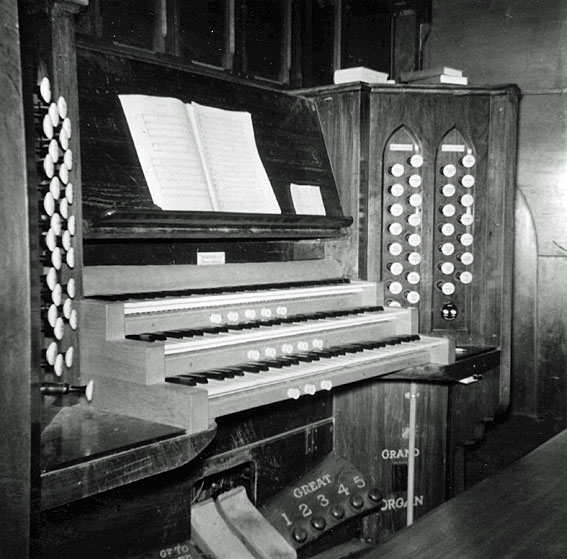
All Saints' Anglican Church, East St Kilda: the Roberts organ – console
[photograph by W.G.S. Smith (circa 1970s)]
The tubular-pneumatic action became increasingly problematic and in 1969 the key and stop actions were converted to electro-pneumatic by Laurie Pipe Organs, who also provided new manual key sets.
The whole organ was rebuilt in 1982-83 by Robert Heatley and Australian Pipe Organs Pty Ltd. New stop jambs and drawstops were provided and some tonal changes were made and inferior wooden ranks were replaced by new material:
| GREAT Double Open Diapason Open Diapason I Open Diapason II Harmonic Flute Stopped Diapason Principal Harmonic Flute Twelfth Fifteenth Tierce Mixture 19.22.26 Trumpet Swell to Great Choir to Great |
16 8 8 8 8 4 4 2-2/3 2 1-3/5 III 8 |
A |
new (in place of Viola 8) new added 1990s on Tromba slide |
| SWELL Contra Gamba Open Diapason Rohr Flöte Salicional Viole Celeste Principal Flageolet Full Mixture 15.19.22 Sharp Mixture 26.29 Double Trumpet Trumpet Oboe Clarion Tremulant Swell Sub Octave Swell Octave |
16 8 8 8 8 4 2 III II 16 8 8 4 |
B GG |
new metal bass 1-12 new (in place of Wald Flute 4) |
| CHOIR Lieblich Gedeckt Viole d'Orchestre Dulciana Unda Maris Gemshorn Lieblich Flute Harmonic Piccolo Mixture 19.22 Clarinet Orchestral Oboe Tremulant Tromba Octave Tromba Choir Sub Octave Choir Octave Swell to Choir |
8 8 8 8 4 4 2 II 8 8 8 4 |
GG C C |
(enclosed except Tromba) new (in place of Lieblich Gedact 16) new (in place of Vox Humana 8) new extension |
| PEDAL Open Wood Open Metal Sub Bass Gamba Quint Principal Flute Fifteenth Quartane 19.22 Trombone Tromba Great to Pedal Swell to Pedal Choir to Pedal |
16 16 16 16 10-2/3 8 8 4 II 16 8 |
A D B D E D E C C |
new new new 1-12 from C |
Great and Pedal Pistons Coupled
Compass: 61/3012
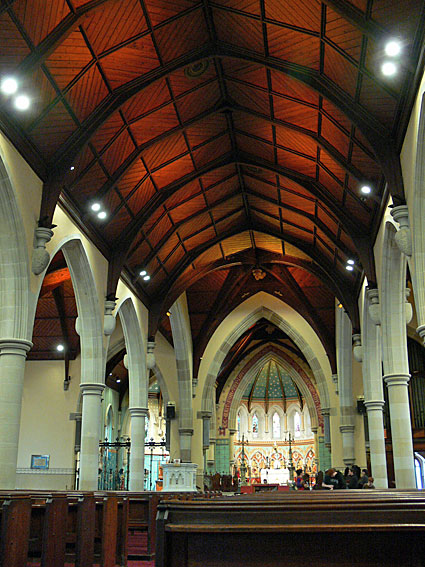
All Saints' Anglican Church, East St Kilda: the interior viewed from rear of nave
[photograph by John Maidment (21 November 2008)]
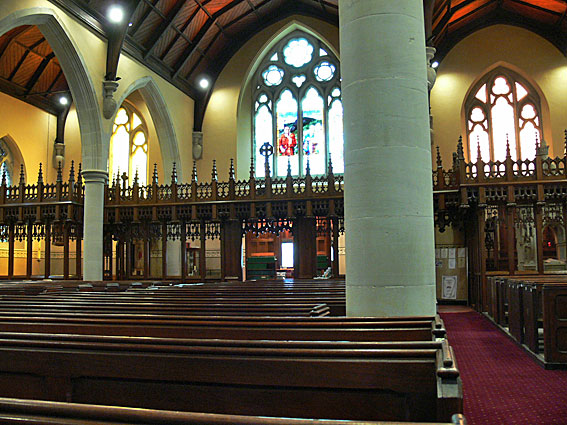
All Saints' Anglican Church, East St Kilda: the screen at the west end
[photograph by John Maidment (21 November 2008)]
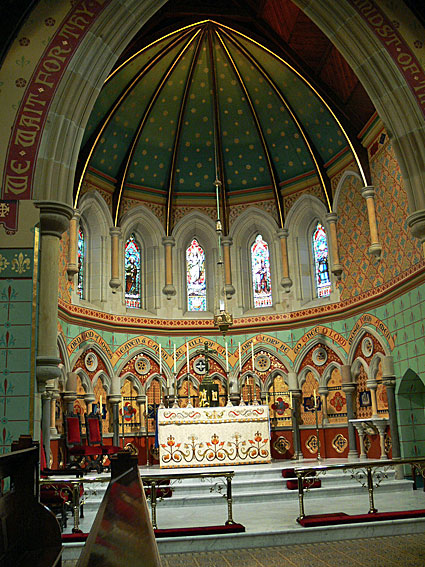
All Saints' Anglican Church, East St Kilda: the sanctuary
[photograph by John Maidment (21 November 2008)]
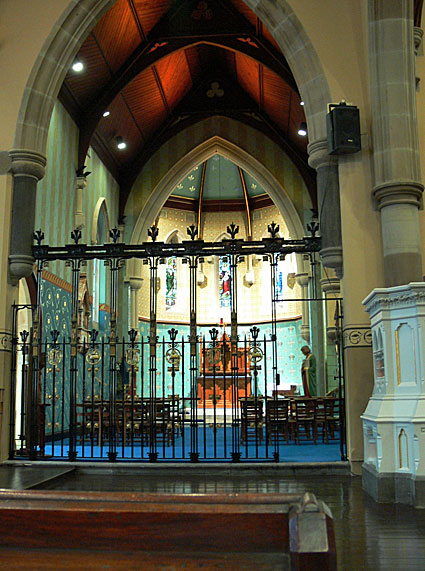
All Saints' Anglican Church, East St Kilda: the chapel screen by Nelson Dawson
[photograph by John Maidment (21 November 2008)]
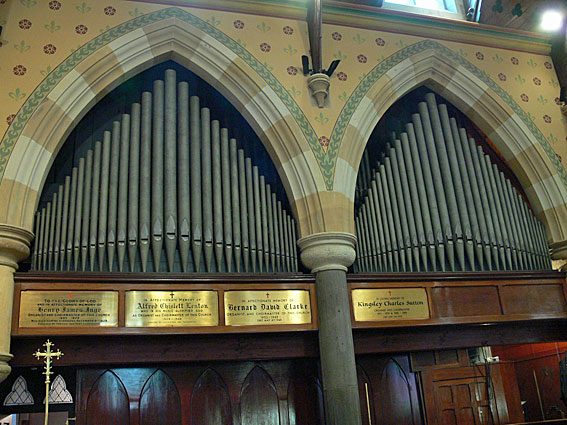
All Saints' Anglican Church, East St Kilda: the Roberts organ – chancel facades
[photograph by John Maidment (21 November 2008)]
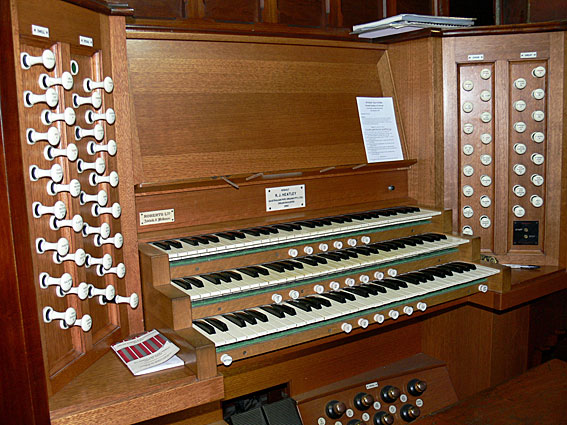
All Saints' Anglican Church, East St Kilda: the 1982 console
[photograph by John Maidment (9 December 2012)]
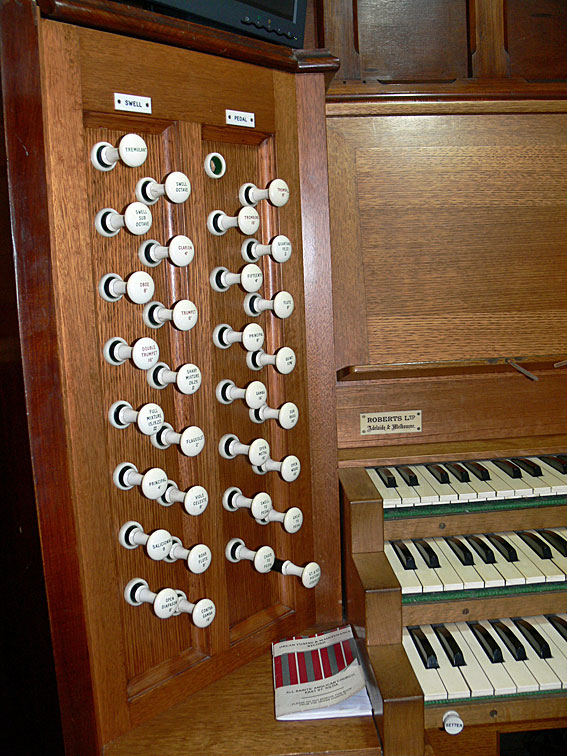
All Saints' Anglican Church, East St Kilda: the 1982 console – left-hand stop jamb
[photograph by John Maidment (9 December 2012)]

All Saints' Anglican Church, East St Kilda: the 1982 console – right-hand stop jamb
[photograph by John Maidment (9 December 2012)]

All Saints' Anglican Church, East St Kilda: the 1982 console – 1924 and 1982 builder's nameplates
[photograph by John Maidment (9 December 2012)]
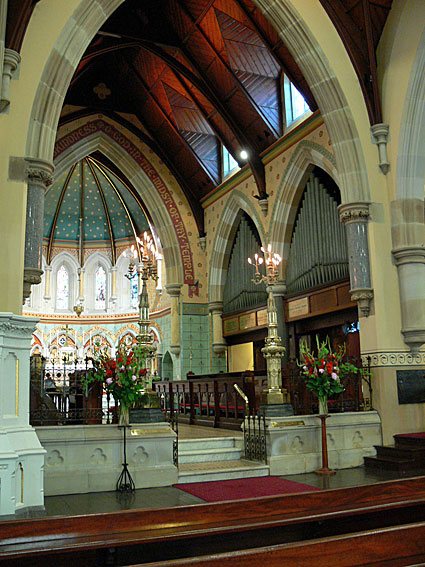
All Saints' Anglican Church, East St Kilda: the chancel showing the gas candelabra
[photograph by John Maidment (9 December 2012)]
1 I.N. McLaren, All Saints' Church, East St Kilda, 1858-1958, pp.8-10
2 The Encyclopedia of Australian Architecture, edited by Philip Goad and Julie Willis. Port Melbourne: Cambridge University Press, 2012, p.82
3 Illustrated London News, 17 March 1860
4 Australasian Sketcher, 28 October 1876, p.118
5 The Argus, 29 October 1868, p.5
6 The Argus, 26 January 1872, p.4
7 Specification noted by John Maidment 1966, 1974
8 See the work: Frederick Heathcote Sutton, Church Organs: their Position and Construction. 3rd ed. London: Rivingtons, 1883, as republished Oxford: Positif Press, 1998. See examples of this at Brant Broughton (p.27), Plumtree (p.33), Worting (p.35)
9 The Argus, 9 October 1924, p.7
10 See the work Graeme D. Rushworth, Historic Organs of New South Wales… Sydney: Hale & Iremonger, 1988, pp 199-203 for further details of his life and career
11 Specification noted by John Maidment 1960
12 John Beaverstock, 'Another Rebuild…', Victorian Organ Journal (December 1983), pp.11-14 and further details from John Maidment